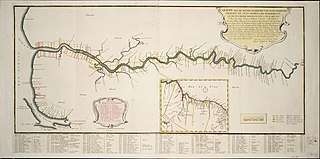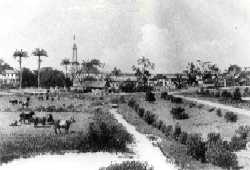
Georgetown is the capital and largest city of Guyana. It is situated in Demerara-Mahaica, region 4, on the Atlantic Ocean coast, at the mouth of the Demerara River. It is nicknamed the "Garden City of the Caribbean." It is the retail, administrative, and financial services centre of the country, and the city accounts for a large portion of Guyana's GDP. The city recorded a population of 118,363 in the 2012 census.
The history of Guyana begins about 35,000 years ago with the arrival of humans coming from Eurasia. These migrants became the Carib and Arawak tribes, who met Alonso de Ojeda's first expedition from Spain in 1499 at the Essequibo River. In the ensuing colonial era, Guyana's government was defined by the successive policies of the French, Dutch, and British settlers. During the colonial period, Guyana's economy was focused on plantation agriculture, which initially depended on slave labor. Guyana saw major slave rebellions in 1763 and 1823. Following the Slavery Abolition Act of 1833, 800,000 enslaved Africans in the Caribbean and South Africa were freed, resulting in plantations contracting indentured workers, mainly from India. Eventually, these Indians joined forces with Afro-Guyanese descendants of slaves to demand equal rights in government and society. After the Second World War, the British Empire pursued policy decolonization of its overseas territories, with independence granted to British Guiana on May 26, 1966. Following independence, Forbes Burnham rose to power, quickly becoming an authoritarian leader, pledging to bring socialism to Guyana. His power began to weaken following international attention brought to Guyana in wake of the Jonestown mass murder suicide in 1978.

British Guiana was a British colony, part of the mainland British West Indies, which resides on the northern coast of South America. Since 1966 it has been known as the independent nation of Guyana.

Demerara is a historical region in the Guianas, on the north coast of South America, now part of the country of Guyana. It was a colony of the Dutch West India Company between 1745 and 1792 and a colony of the Dutch state from 1792 until 1815. It was merged with Essequibo in 1812 by the British who took control. It formally became a British colony in 1815 until Demerara-Essequibo was merged with Berbice to form the colony of British Guiana in 1831. In 1838, it became a county of British Guiana until 1958. In 1966, British Guiana gained independence as Guyana and in 1970 it became a republic as the Co-operative Republic of Guyana. It was located around the lower course of the Demerara River, and its main settlement was Georgetown.
The music of Guyana encompasses a range of musical styles and genres that draw from various influences including: Indian, Latino-Hispanic, European, African, Chinese, and Amerindian music. Popular Guyanese performers include: Terry Gajraj, Eddy Grant, Dave Martins & the Tradewinds, Aubrey Cummings, Colle´ Kharis and Nicky Porter. Eddie Hooper The Guyana Music Festival has proven to be influential on the Guyana music scene.

Islam in Guyana is the third largest religion in the country after Christianity and Hinduism, respectively. According to the 2012 census, 7% of the country’s population is Muslim. However, a Pew Research survey from 2010 estimates that 6.4% of the country is Muslim. Islam was first introduced to Guyana via slaves from West Africa, but was suppressed on plantations until Muslims from British India were brought to the country as indentured labour. The current President of Guyana, Mohamed Irfaan Ali is the first Muslim president.

Linden is the second largest city in Guyana after Georgetown, and capital of the Upper Demerara-Berbice region, located at 6°0′0″N58°18′0″W, altitude 48 m (160 ft). It was declared a town in 1970, and includes the communities of MacKenzie, Christianburg, and Wismar. It lies on the Demerara River and has a population of 27,277 as of 2012. It is primarily a bauxite mining town, containing many mines 60–90 m deep, with many other pits now in disuse.

Berbice is a region along the Berbice River in Guyana, which was between 1627 and 1792 a colony of the Dutch West India Company and between 1792 and 1815 a colony of the Dutch state. After having been ceded to the United Kingdom of Great Britain and Ireland in the latter year, it was merged with Demerara-Essequibo to form the colony of British Guiana in 1831. It became a county of British Guiana in 1838 till 1958. In 1966, British Guiana gained independence as Guyana and in 1970 it became a republic as the Co-operative Republic of Guyana.

Afro-Guyanese are generally descended from the enslaved people brought to Guyana from the coast of West Africa to work on sugar plantations during the era of the Atlantic slave trade. Coming from a wide array of backgrounds and enduring conditions that severely constrained their ability to preserve their respective cultural traditions contributed to the adoption of Christianity and the values of British colonists.
The Railways of Guyana comprised two public railways, the Demerara-Berbice Railway and the Demerara-Essequibo Railway. There are also several industrial railways mainly for the bauxite industry. The Demerara-Berbice Railway is the oldest in South America. None of the railways are in operation in the 21st century.
Annandale is a community in the Demerara-Mahaica region of Guyana, located on the Atlantic Ocean between Buxton, and Lusignan. Many of the inhabitants originally came from the Lusignan estate, while the former slaves of the plantation, bought the neighbouring Orange Nassau plantation and named it Buxton. Annandale is mainly an Indo-Guyanese community. It is divided in Annandale North, South, West and Courabane Park. The economy used to be dependent on the nearby sugar estates. The secondary school for the region is located in Annandale.

Rockstone is a village on the right bank of the Essequibo River in the Upper Demerara-Berbice Region of Guyana, altitude 6 metres. Rockstone is approximately 26 km west of Linden and is linked by road.

Quamina Gladstone, most often referred to simply as Quamina, was a Guyanese slave from Africa and father of Jack Gladstone. He and his son were involved in the Demerara rebellion of 1823, one of the largest slave revolts in the British colonies before slavery was abolished.
Den Amstel is a village in Guyana's Essequibo Islands-West Demerara region. It lies on the Atlantic coast, approximately 13 kilometres (8.1 mi) west-north-west of the capital, Georgetown. The village has a population of 938 people as of 2012, who are predominantly Afro-Guyanese.

Plantation Peter's Hall was a plantation on the east bank of the River Demerara in Dutch Guiana and British Guiana. It was probably laid out in the mid-eighteenth century and by the early nineteenth century had over 200 slaves before that institution was abolished in the British Empire.
Werk-en-rust, also Werken-Rust, is a ward in Georgetown, Guyana, located along the Demerara River that feeds into the Atlantic Ocean.
Cummingsburg, or historically Cumingsburg, is a ward in Georgetown, Guyana. It began as 500-acre plantation, La Bourgade about 1759. When Thomas Cumming, a Scotsman, bought the property, he developed a town plan with residential and commercial lots and streets. The town layout was modified after a fire that burnt much of the town in 1864. Today, it is the site of several museums, including a national and anthropological museum.
Guyanese nationality law is regulated by the 1980 Constitution of Guyana, as amended; the Citizenship Act of 1967, and its revisions; and various British Nationality laws. These laws determine who is, or is eligible to be, a national of Guyana. Guyanese nationality is typically obtained either on the principle of jus soli, i.e. by birth in Guyana; or under the rules of jus sanguinis, i.e. by birth abroad to parents with Guyanese nationality. It can also be granted to persons with an affiliation to the country, or to a permanent resident who has lived in the country for a given period of time through naturalisation. There is not currently a program in Guyana for persons to acquire nationality through investment in the country. Nationality establishes one's international identity as a member of a sovereign nation. Though it is not synonymous with citizenship, for rights granted under domestic law for domestic purposes, the United Kingdom, and thus the Commonwealth, have traditionally used the words interchangeably.
Helena is a village in the Demerara-Mahaica Region of Guyana. Administratively the village is subdivided in Helena No.1 and Helena No.2 and is part of the Mahaica subregion.

Kingston is a former village in Demerara. In 1837, it became a ward of Georgetown. The ward is located along the Atlantic Ocean coast. Kingston is home to many landmarks and historic buildings.











